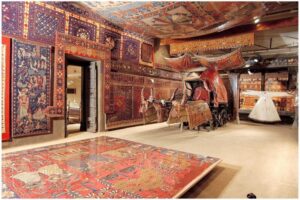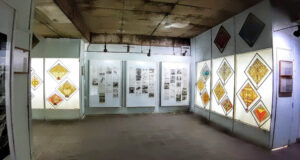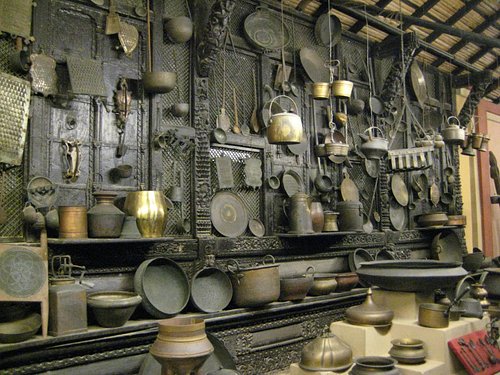Museums may serve as an anchor during stormy times. It might frequently appear to people who aren’t as enthralled with museums as readers of this article that these establishments are just where lost artefacts go to live out their last years.
However, there’s a compelling argument to be made that the museum is more important now than it has ever been. Museums have the ability to both reflect and influence our society, as it can tackle important societal issues and change our perception of the future. Ahmedabad houses amazing museums which one must visit. Here is the list:
Calico Museum of Textiles



 The goal of this textile museum is to present Indian textiles and weaving skills spanning centuries. The museum is home to a world-class collection of handcrafted, up to 500-year-old Indian textiles, both modern and antique. Some really exquisite pieces with amazing dexterity and richness are on show here. The museum is only open for a few hours every day, reservations must be made in advance.
The goal of this textile museum is to present Indian textiles and weaving skills spanning centuries. The museum is home to a world-class collection of handcrafted, up to 500-year-old Indian textiles, both modern and antique. Some really exquisite pieces with amazing dexterity and richness are on show here. The museum is only open for a few hours every day, reservations must be made in advance.
Patang Kite Museum



 The history and usage of kites, an important aspect of Ahmedabadi culture, are the focus of this Museum. Rare and patterned kites from all around the world are on exhibit at the museum for visitors to admire and learn about their historical significance and beauty. Mr. Bhanubhai Shah’s kind contribution was the catalyst for it all. For around fifty years, he possessed a collection of kites, many of which are currently on show in the museum. Few of the kites at the Museum are as ancient as seventy years, but they come in a variety of sizes, forms, and colours. In addition to the kites, there are stunning drawings and details on international kite flying customs.
The history and usage of kites, an important aspect of Ahmedabadi culture, are the focus of this Museum. Rare and patterned kites from all around the world are on exhibit at the museum for visitors to admire and learn about their historical significance and beauty. Mr. Bhanubhai Shah’s kind contribution was the catalyst for it all. For around fifty years, he possessed a collection of kites, many of which are currently on show in the museum. Few of the kites at the Museum are as ancient as seventy years, but they come in a variety of sizes, forms, and colours. In addition to the kites, there are stunning drawings and details on international kite flying customs.
Auto World Vintage Car Museum

 Some of India’s most exquisite vintage automobiles are on display at this museum. There are 112 vehicles in the collection. Both history fans and auto lovers should make time to visit. It’s a unique experience because of the collection, which includes everything from convertibles to fancy antique automobiles to horse-drawn carriages.
Some of India’s most exquisite vintage automobiles are on display at this museum. There are 112 vehicles in the collection. Both history fans and auto lovers should make time to visit. It’s a unique experience because of the collection, which includes everything from convertibles to fancy antique automobiles to horse-drawn carriages.
Veechaar Museum

 With a vast collection of historical objects spanning hundreds of years to the present, the Vechaar Museum is designed like a mud house. It is 6 miles away from the city centre and is a veritable gold mine of vintage home furnishings. One of India’s largest collections of kitchenware is housed in the Veechaar Museum. It is worth a visit to view their outstanding collection of large-scale cookware, ornamental boxes, containers, jars, and utensils made of brass, copper, and bronze. They have assembled examples from throughout the world in well-designed sections.
With a vast collection of historical objects spanning hundreds of years to the present, the Vechaar Museum is designed like a mud house. It is 6 miles away from the city centre and is a veritable gold mine of vintage home furnishings. One of India’s largest collections of kitchenware is housed in the Veechaar Museum. It is worth a visit to view their outstanding collection of large-scale cookware, ornamental boxes, containers, jars, and utensils made of brass, copper, and bronze. They have assembled examples from throughout the world in well-designed sections.
Conflictorium

 The Conflictorium, also known as the Museum of Conflict, is an intriguing and distinctive museum that focuses on historical wars. It’s for intellectuals, innovators, and those who don’t mind exploring the negative aspects of things. The museum, which is situated in Mirzapur neighbourhood, features a range of displays designed to encourage discussion on past conflicts.
The Conflictorium, also known as the Museum of Conflict, is an intriguing and distinctive museum that focuses on historical wars. It’s for intellectuals, innovators, and those who don’t mind exploring the negative aspects of things. The museum, which is situated in Mirzapur neighbourhood, features a range of displays designed to encourage discussion on past conflicts.
Tribal Museum


Artefacts and clothing from Gujarat’s indigenous group are housed in this Museum. Although it is one of Ahmedabad’s lesser-known museums, anybody curious about the many Indian tribes should definitely check it out. The museum is decorated with various items from the tribal way of life, such as toys, garments, and decorations, and it was constructed to imitate a tribe’s dwelling.
Jethabhai ni Haveli

 A stunning heritage building that is kept up well, the Toy Museum in Jethabhai ni Haveli is home to an amazing collection of toys from all around the world. Toy enthusiasts should definitely check out the museum, which draws visitors of all ages. The toys are quite attractive to look at and represent the Indian cultural heritage.
A stunning heritage building that is kept up well, the Toy Museum in Jethabhai ni Haveli is home to an amazing collection of toys from all around the world. Toy enthusiasts should definitely check out the museum, which draws visitors of all ages. The toys are quite attractive to look at and represent the Indian cultural heritage.
Philatelic Museum of Indian Stamps

 A large collection of uncommon postal stamps from 1800 may be seen in the Philatelic Museum of Indian Stamps. Even though the museum is not very well-known, it nonetheless has an enormous collection of postal stamps. Visiting this museum is a fun way to understand the complexity of communication in the past.
A large collection of uncommon postal stamps from 1800 may be seen in the Philatelic Museum of Indian Stamps. Even though the museum is not very well-known, it nonetheless has an enormous collection of postal stamps. Visiting this museum is a fun way to understand the complexity of communication in the past.
Kasturbhai Lalbhai Museum

 Housed in a house from the colonial era, the Kasturbhai Lalbhai Museum showcases a variety of folk and traditional art pieces from different Indian schools. A beautiful private collection of Gaganendranath Tagore’s paintings and furnishings is also housed at the museum. This place is home to two exhibits. The Indigo Museum is one place where contemporary abstract art is displayed, while the primary museum is located in the bungalow. Along with several rooms of a magnificent palace, you may view some tiny paintings from the Maratha-Mughal era and Kangra paintings.
Housed in a house from the colonial era, the Kasturbhai Lalbhai Museum showcases a variety of folk and traditional art pieces from different Indian schools. A beautiful private collection of Gaganendranath Tagore’s paintings and furnishings is also housed at the museum. This place is home to two exhibits. The Indigo Museum is one place where contemporary abstract art is displayed, while the primary museum is located in the bungalow. Along with several rooms of a magnificent palace, you may view some tiny paintings from the Maratha-Mughal era and Kangra paintings.
Sanskar Kendra Art Museum

 Its goal is to present the city’s architectural design, culture, and artwork. It features displays that span several centuries, encompassing history, art, and customs, and some of them date back to the eleventh century. It has a number of exhibitions that highlight the history, way of life, and architectural design of the city. It portrays Ahmedabad’s journey in all of its varied aspects. The images depict Ahmedabad’s growth to its current state. Additionally, a number of documents and images tell the tale of the fight for independence. Ancient artefacts and sculptures from all around Gujarat may also be seen at the museum. They’ve been displayed with textual and illustrative panels.
Its goal is to present the city’s architectural design, culture, and artwork. It features displays that span several centuries, encompassing history, art, and customs, and some of them date back to the eleventh century. It has a number of exhibitions that highlight the history, way of life, and architectural design of the city. It portrays Ahmedabad’s journey in all of its varied aspects. The images depict Ahmedabad’s growth to its current state. Additionally, a number of documents and images tell the tale of the fight for independence. Ancient artefacts and sculptures from all around Gujarat may also be seen at the museum. They’ve been displayed with textual and illustrative panels.








